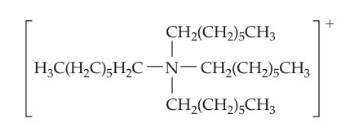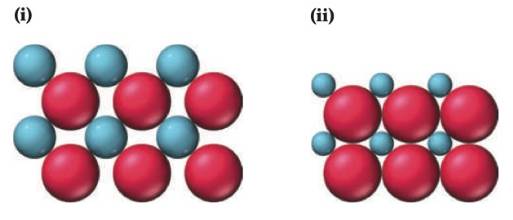
Chemistry, Books a la Carte Edition and Modified Mastering Chemistry with Pearson eText & ValuePack Access Card (7th Edition)
7th Edition
ISBN: 9780134172514
Author: John E. McMurry
Publisher: PEARSON
expand_more
expand_more
format_list_bulleted
Textbook Question
Chapter 6, Problem 6.18P
PROBLEM 6.18 Compare the following two ionic liquids: tetraheptylammonium bromide and tetraheptylammonium iodide. Thestructure of the tetraheptylammonium ion is:

(a) Which picture corresponds to tetraheptylammonium bromide and which to tetraheptylammonium iodide?

(b) Which ionic liquid has a larger lattice energy?
(c) One ionic liquid has a melting point of 88 °C and the other has a melting point of 39 °C. Match the ionic liquid to its melting point.
Expert Solution & Answer
Want to see the full answer?
Check out a sample textbook solution
Students have asked these similar questions
2. Propose a mechanism for this reaction.
ہلی سے ملی
N
H
(excess)
Steps and explanationn please.
Problem 5-48
Assign R or S configurations to the chirality centers in ascorbic acid (vitamin C).
OH
H
OH
HO
CH2OH Ascorbic acid
O H
Problem 5-49
Assign R or S stereochemistry to the chirality centers in the following Newman projections:
H
Cl
H
CH3
H3C.
OH
H3C
(a)
H
H
H3C
(b)
CH3
H
Problem 5-52
Draw the meso form of each of the following molecules, and indicate the plane of symmetry in each:
OH
OH
(a)
CH3CHCH2CH2CHCH3
CH3
H3C.
-OH
(c) H3C
CH3
(b)
Problem 5-66
Assign R or S configurations to the chiral centers in cephalexin, trade-named Keflex, the most widely prescribed
antibiotic in the United States.
H2N H
IHH
S
Cephalexin
N.
CH3
CO₂H
Chapter 6 Solutions
Chemistry, Books a la Carte Edition and Modified Mastering Chemistry with Pearson eText & ValuePack Access Card (7th Edition)
Ch. 6 - Prob. 6.1PCh. 6 - APPLY 6.2 Which of the following sets of ions are...Ch. 6 - Prob. 6.3PCh. 6 - Conceptual APPLY 6.4 Which of the following...Ch. 6 - Prob. 6.5PCh. 6 - Prob. 6.6ACh. 6 - Prob. 6.7PCh. 6 - Conceptual APPLY 6.8 The figure on the right...Ch. 6 - Prob. 6.9PCh. 6 - Conceptual APPLY 6.10 Which of the indicated three...
Ch. 6 - Prob. 6.11PCh. 6 - Prob. 6.12ACh. 6 - Prob. 6.13PCh. 6 - APPLY 6.14 Calculate the energy of electrostatic...Ch. 6 - Prob. 6.15PCh. 6 - Conceptual APPLY 6.16 One of the following...Ch. 6 - Prob. 6.17PCh. 6 - PROBLEM 6.18 Compare the following two ionic...Ch. 6 - PROBLEM 6.19 An ionic liquid consisting of a bulky...Ch. 6 - Where on the periodic table would you find the...Ch. 6 - Which of the following spheres is likely to...Ch. 6 - Circle the approximate part or parts of the...Ch. 6 - Prob. 6.23CPCh. 6 - This figure represents the successive ionization...Ch. 6 - In the following drawings, red spheres represent...Ch. 6 - Which of the following drawings is more likely to...Ch. 6 - Prob. 6.27CPCh. 6 - Which of the following alkali metal halides has...Ch. 6 - Which of the following alkali metal halides has...Ch. 6 - Three binary compounds are represented on the...Ch. 6 - Given the following values for the formation of...Ch. 6 - What is the difference between a covalent bond and...Ch. 6 - Prob. 6.33SPCh. 6 - What is the difference between a molecule and an...Ch. 6 - Prob. 6.35SPCh. 6 - How many protons and electrons are in each of the...Ch. 6 - What is the identity of the element X in the...Ch. 6 - Prob. 6.38SPCh. 6 - Prob. 6.39SPCh. 6 - Prob. 6.40SPCh. 6 - Prob. 6.41SPCh. 6 - What doubly positive ion has the following...Ch. 6 - Prob. 6.43SPCh. 6 - Prob. 6.44SPCh. 6 - Which element in the transition-metal series Sc...Ch. 6 - Prob. 6.46SPCh. 6 - Prob. 6.47SPCh. 6 - Prob. 6.48SPCh. 6 - Prob. 6.49SPCh. 6 - Prob. 6.50SPCh. 6 - Prob. 6.51SPCh. 6 - Prob. 6.52SPCh. 6 - Prob. 6.53SPCh. 6 - Prob. 6.54SPCh. 6 - Prob. 6.55SPCh. 6 - Prob. 6.56SPCh. 6 - Prob. 6.57SPCh. 6 - Prob. 6.58SPCh. 6 - Prob. 6.59SPCh. 6 - What is the relationship between the electron...Ch. 6 - Prob. 6.61SPCh. 6 - Prob. 6.62SPCh. 6 - Prob. 6.63SPCh. 6 - Prob. 6.64SPCh. 6 - Prob. 6.65SPCh. 6 - Prob. 6.66SPCh. 6 - Prob. 6.67SPCh. 6 - Prob. 6.68SPCh. 6 - Prob. 6.69SPCh. 6 - Prob. 6.70SPCh. 6 - Prob. 6.71SPCh. 6 - Prob. 6.72SPCh. 6 - Prob. 6.73SPCh. 6 - Prob. 6.74SPCh. 6 - Prob. 6.75SPCh. 6 - Find the lattice energy of LiBr(s) in Table 6.3,...Ch. 6 - Prob. 6.77SPCh. 6 - Prob. 6.78SPCh. 6 - Prob. 6.79SPCh. 6 - Prob. 6.80SPCh. 6 - Prob. 6.81SPCh. 6 - Prob. 6.82SPCh. 6 - Prob. 6.83SPCh. 6 - Use the data and the result in Problem 6.78 to...Ch. 6 - Prob. 6.85SPCh. 6 - Prob. 6.86CPCh. 6 - Prob. 6.87CPCh. 6 - Prob. 6.88CPCh. 6 - Prob. 6.89CPCh. 6 - Prob. 6.90CPCh. 6 - Prob. 6.91CPCh. 6 - Prob. 6.92CPCh. 6 - Prob. 6.93CPCh. 6 - Prob. 6.94CPCh. 6 - Prob. 6.95CPCh. 6 - Prob. 6.96CPCh. 6 - Prob. 6.97CPCh. 6 - Prob. 6.98CPCh. 6 - Consider the electronic structure of the element...Ch. 6 - Prob. 6.100MPCh. 6 - Prob. 6.101MP
Knowledge Booster
Learn more about
Need a deep-dive on the concept behind this application? Look no further. Learn more about this topic, chemistry and related others by exploring similar questions and additional content below.Similar questions
- "Water gas" is an industrial fuel composed of a mixture of carbon monoxide and hydrogen gases. When this fuel is burned, carbon dioxide and water result. From the information given below, write a balanced equation and determine the enthalpy of this reaction: CO(g) + O2(g) → CO₂(g) + 282.8 kJ H2(g) + O2(g) → H₂O(g) + 241.8 kJ MacBook Airarrow_forwardPage of 3 4. Calculate AG for the following reaction at 25°C. Will the reaction occur (be spontaneous)? How do you know? NH3(g) + HCl(g) → NH4Cl(s) AH=-176.0 kJ AS-284.8 J-K-1arrow_forwardtrue or false The equilibrium constant for this reaction is 0.20. N2O4(g) ⇔ 2NO2(g) Based on the above, the equilibrium constant for the following reaction is 5. 4NO2(g) ⇔ 2N2O4(g)arrow_forward
arrow_back_ios
SEE MORE QUESTIONS
arrow_forward_ios
Recommended textbooks for you
- Chemistry: Matter and ChangeChemistryISBN:9780078746376Author:Dinah Zike, Laurel Dingrando, Nicholas Hainen, Cheryl WistromPublisher:Glencoe/McGraw-Hill School Pub Co
 World of Chemistry, 3rd editionChemistryISBN:9781133109655Author:Steven S. Zumdahl, Susan L. Zumdahl, Donald J. DeCostePublisher:Brooks / Cole / Cengage Learning
World of Chemistry, 3rd editionChemistryISBN:9781133109655Author:Steven S. Zumdahl, Susan L. Zumdahl, Donald J. DeCostePublisher:Brooks / Cole / Cengage Learning


Chemistry: Matter and Change
Chemistry
ISBN:9780078746376
Author:Dinah Zike, Laurel Dingrando, Nicholas Hainen, Cheryl Wistrom
Publisher:Glencoe/McGraw-Hill School Pub Co

World of Chemistry, 3rd edition
Chemistry
ISBN:9781133109655
Author:Steven S. Zumdahl, Susan L. Zumdahl, Donald J. DeCoste
Publisher:Brooks / Cole / Cengage Learning
Periodic Properties of Elements | Chemistry | IIT-JEE | NEET | CBSE | Misostudy; Author: Misostudy;https://www.youtube.com/watch?v=L26rRWz4_AI;License: Standard YouTube License, CC-BY
Periodic Trends: Electronegativity, Ionization Energy, Atomic Radius - TUTOR HOTLINE; Author: Melissa Maribel;https://www.youtube.com/watch?v=0h8q1GIQ-H4;License: Standard YouTube License, CC-BY